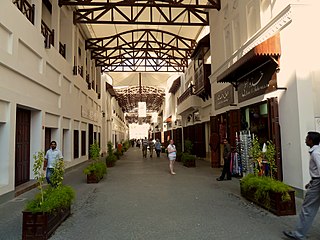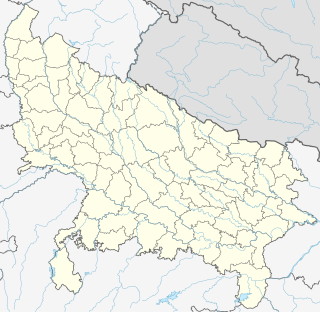
A souq or souk is a marketplace or commercial quarter in Western Asian, North African and some Horn African cities. The term souq goes by many alternatives in different parts of the world; in the Balkans, the term bedesten is used; in Malta the terms suq and sometimes monti are used for a marketplace; and in northern Morocco, the Spanish corruption socco is often used. The equivalent Persian term is "bazaar". In general a souq is synonymous with a bazaar or marketplace, and the term souq is used in Arabic-speaking countries.

Muharraq is Bahrain's third largest city and served as its capital until 1932 when it was replaced by Manama. The population of Muharraq in 2012 was 176,583.

Bab Al Bahrain is a historical building located in the Customs Square in Manama's former central business district. It marks the main entrance to the Manama Souq. Designed by Sir Charles Belgrave, adviser to the Emir and completed in 1949, Bab Al Bahrain once stood close to the water's edge. Due to extensive land reclamation in the later years, the sea is located a few kilometres north.

Khan el-Khalili is a major souk in the historic center of Islamic Cairo. The bazaar district is one of Cairo's main attractions for tourists and Egyptians alike.

Diraz is the biggest and most populated village on the northwest coast of Bahrain. It lies to the east of Budaiya, west of Barbar and north of Bani Jamra. Two Dilmun era archaeological sites, namely Diraz Temple and Ain Umm Sujoor, are located in this village.

The Ajam of Bahrain or Persian Bahrainis or Iranian Bahrainis are an ethnic group in Bahrain composed of Shia Bahraini citizens of non-Arab Iranian national background.

The Central Business District (CBD) is located in central Manama, the capital of Bahrain. Many of the city's hotels, office buildings, shops and restaurants are located in the CBD. It lies along the northern coast of Manama.

Hallaur or Hallor village is located in Domariyaganj Tehsil of Siddharthnagar district in Uttar Pradesh, India. Domariyaganj is the nearest town to Hallaur village.

Awadhiya is a new neighborhood of Manama, the capital city of Bahrain. It lies roughly between Ras Rumman and Hoora, while the Manama Souq lies to Awadhiya's west. The neighborhood was originally settled by merchants of Huwala origin, especially from Larestan and Bastak. Today the area is a busy commercial district. The neighborhood contains some of the last remaining houses built in the traditional architectural style featuring badgeer windtowers.

Aïn El Hammam is a town and commune in Tizi Ouzou Province in northern Algeria.

The Ancient City of Aleppo is the historic city centre of Aleppo, Syria. Before the Syrian Civil War, many districts of the ancient city remained essentially unchanged since its construction during the 12th to the 16th century. Being subjected to constant invasions and political instability, the inhabitants of the city were forced to build cell-like quarters and districts that were socially and economically independent. Each district was characterized by the religious and ethnic characteristics of its inhabitants.
Matam Bin Rajab is the first Matam in Manama, located in the Fareeq el-Hatab district of that city.
Fareej el-Hatab is an old district close to the Manama Souq, in the heart of Manama in the Kingdom of Bahrain. It is located adjacent to Fareej el-Makharqa. Along with the other districts in the souq, it formed the core districts of Manama prior to the expansion of the city in the 20th century. The first Matam in all of Manama, Matam Bin Rajab, is located in Fareeq el-Hatab.
Fareej el-Fadhel is a core district of Manama, neighbouring the Manama Souq, in the Kingdom of Bahrain. It is adjacent to Fareej el-Makharqa. Along with the other districts of the souq in Manama, it formed the core districts of the city prior to the expansion of the city in the 20th century.
Fareej Mushbir is an old district neighbouring the Manama Souq, in the city of Manama, Bahrain. The district was part of the original core of Old Manama, prior to its expansion in the 20th century.

Hammam al-Nahhasin is one of the oldest and largest public baths in Aleppo, Syria. It is located in Al-Madina Souq of the Ancient City of Aleppo, to the south of the Great Umayyad Mosque, near Khan al-Nahhasin. It was originally built in the 12th century and renovated several times during the Mamluk and Ottoman periods. However, most of the current building of the hammam belongs to the Ottoman period. Hammam al-Nahhasin literally means the bath of the coppersmiths.

The Islamic month of Muharram is a period of mourning in Shia Islam and commemorates the death of Imam Hussain, the third Imam, and his companions at the Battle of Karbala in 680 AD. Processions called Azadari are held to commemorate and remember the events that took place, these are often organised by congregation halls known as Hussainia. Mourning climaxes on the tenth day of Muharram, Ashura. The mourning is sometimes referred to as the Remembrance of Muharram.

















